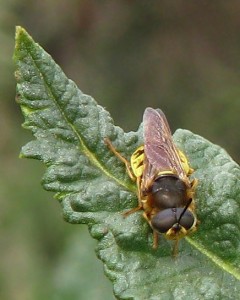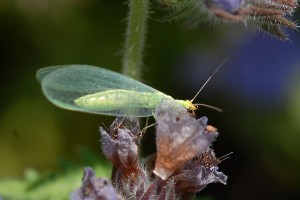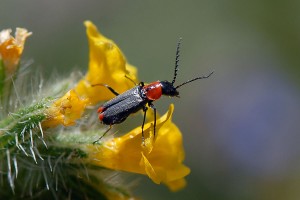Some recent insect photography expeditions have turned up a number of new additions for our BFS Invert List. We have yet to sort through all our photos, but we have so far turned up representatives of three new insect families – Stratiomyidae (Soldier Flies), Chrysopidae (Green Lacewings), and Melyridae (Soft-winged Flower Beetles).
- Soldier Flies (Stratiomyidae) often superficially resemble wasps. Although the most well-known species is black, others are metallic blue, green, or purple, or have bright black and yellow patterns, like the one we spotted at the BFS – Stratiomys maculosa. Adults often sun on leaves, holding their wings crossed scissorlike across their abdomens:
- Chrysopidae (Green Lacewings) are familiar to many gardeners. Although some species of the delicate-looking adults are predatory, adult Chrysoperla – the genus spotted at the BFS – feeds on nectar, pollen, or honeydew.
The larvae, however, are voracious and are used for biological pest control, especially for aphids. Chrysoperla is common throughout North America.
- The larvae of Melyridae (Soft-winged Flower Beetles) are also predatory. Adults of many species are also predaceous, feeding on other insects on flowers, although some adults feed on pollen. They are considered important natural enemies of some agricultural insect pests.
Although Melyridae occur throughout North America, Malachius capillicornis, the species spotted at the BFS, has only been reported from Southern California and Arizona.
Soldier Flies are distributed worldwide, but Stratiomys maculosa is strictly a west coast species found in inland valleys and deserts from British Columbia to Southern California and east to Nevada and Utah. Soldier Fly larval habitat varies depending upon the species, but they are generally decomposers, living in dung, rotten fruit, or other organic matter. The larvae of the Black Soldier Fly, Hermetia illucens, are widely used for composting. If you’re feeling adventurous, you can watch a video of Black Soldier Fly larvae devouring a hamburger or some rainbow trout! (The trout video is highly recommended!)


